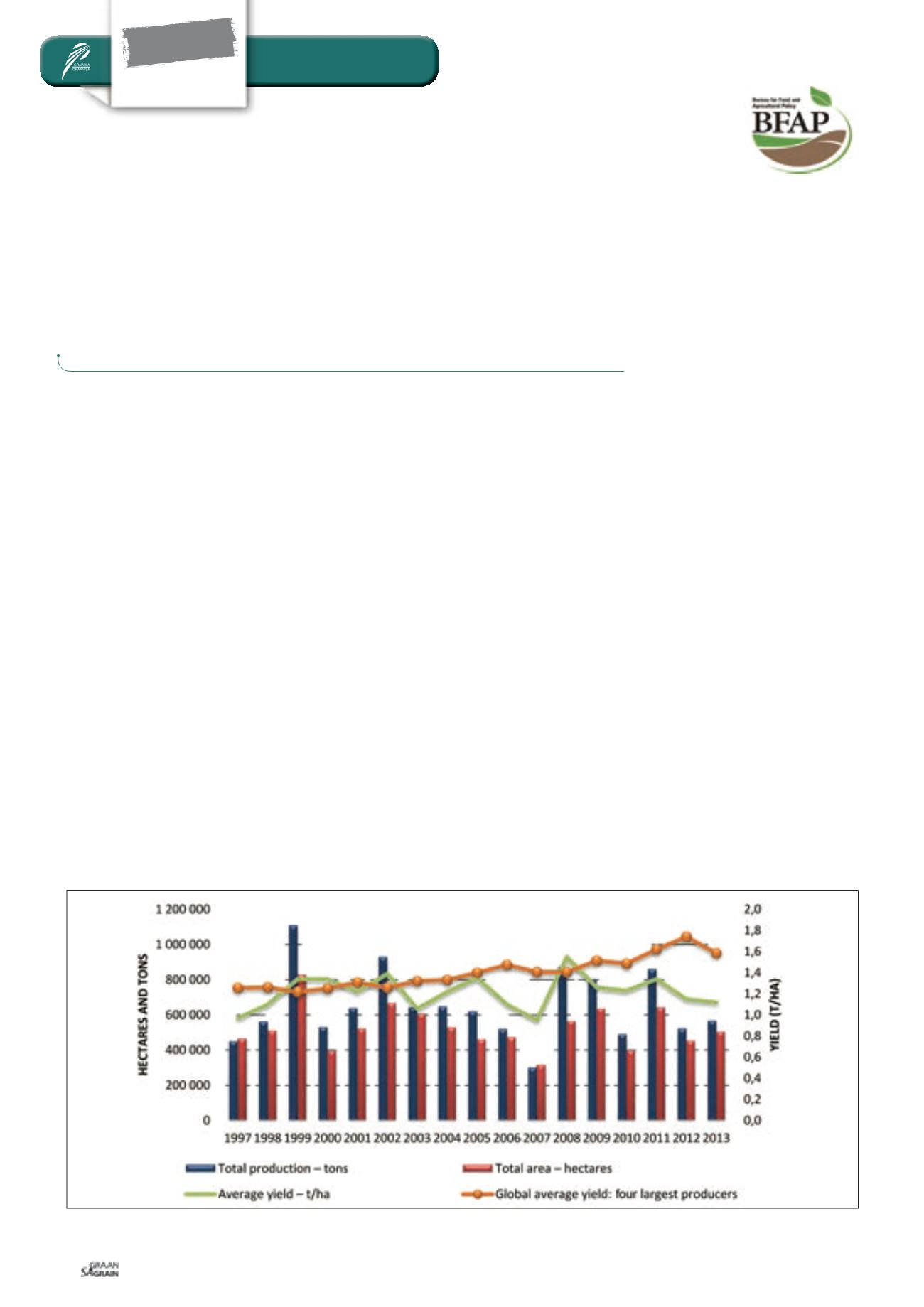

Junie 2015
36
FOCUS
Special
Value adding
The future of sunϐlower
production in South Africa
– a study by the Bureau for Food and Agricultural Policy (BFAP), funded by the
Oilseed Advisory Committee (OAC)
FERDI MEYER
and
GERHARD VAN DER BURGH,
both from the Bureau for Food and Agricultural Policy
O
ver the past two decades, the
South African sunflower industry
has been characterised by volatile
production levels with virtually
no real growth while domestic demand for
oilcake and vegetable oil has increased by
approximately 40%.
The imports of seed, oil and cake have grad-
ually been increasing to meet the rising do-
mestic demand levels. With approximately
double the amount of crushing capacity
available as the amount of sunflower seed
that is produced locally, the question arises
why the local industry can’t fill the gap of
imports and increase the local level of pro-
duction. Although the study took a holistic
view on the sunflower value chain, this arti-
cle will mainly focus on selected key drivers
of sunflower seed production.
Over the years, sunflowers have received
the status of an ideal crop to grow in South
Africa under conditions of low-input farming
and marginal cropping conditions. Sunflow-
ers’ ability to produce relatively consistent
yields under adverse weather conditions
and their overall characteristic of drought-
tolerance makes it an attractive crop for pro-
ducers in dryland production regions.
Sunflowers can also produce a crop on mar-
ginal soils with very little or no additional
fertiliser. In 1999 the sunflower area reached
its peak when 828 000 hectares (
Graph 1
)
were planted. Production is concentrated
in the Free State (FS) and North West
Province (NW), which together account for
79%of the national area planted to sunflower.
Since its peak in 1999, the area planted has
followed a declining trend with greater re-
ductions in the North West Province com-
pared to the other production regions. The
reasons for these reductions differed from
one region to the next and included: The
adoption of new bio-tech maize cultivars
with better yields, practical producer con-
straints e.g. negative sentiments to the crop
based on historic incidents such as poor
emergence, Sclerotinia, falling over prob-
lems, bird damage and the possible exclu-
sion of marginal land under crop cultivation.
However, one underlying factor stood out
in all production regions for why produc-
ers are reluctant to expand the area under
sunflower production, and that is that under
ideal growing conditions or irrigation, sun-
flowers do not provide the same upward
potential as crops like maize and soybeans.
As a consequence, many producers see the
crop as a “catch crop” and preference is not
given to the timing of production, i.e. opti-
mal planting date and climatic conditions
(soils might be too warm or there might be a
lack of moisture, etc.).
It is not uncommon for producers in certain
production regions to leave sunflowers as a
last resort, waiting till the very last day to
plant, ”the 35th of January” in producers’
terms. The adverse effects of the wrong
planting dates have been trailed and prop-
agated to producers and those who have
adapted to guidelines of optimal cropping
practices have achieved improved yields.
It seems as if sunflower hybrids that are
currently available in the local market do
have the genetic potential to produce high-
er yields. Furthermore, the introduction of
advanced Clearfield Plus sunflower breeds
offers a major benefit in the management
of weeds and opens the opportunity for
growing sunflowers in no-till or minimum
till farming systems.
Graph 2
illustrates the gap between the ave-
rage yields obtained in the ARC-GCI yield
trials and the average yields obtained in the
Graph 1: Productivity of the South African sunflower industry.
Source: SAGIS (2014) and Oilworld (2014)

















